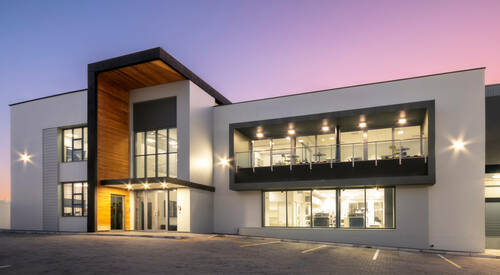Discover the Cutting-edge Services Offered by Commercial Architects for Your Next Task
Commercial architects play an important function fit the developed setting. They mix performance with visual appeal, developing spaces that resonate with brand name identification. These professionals utilize cutting-edge design solutions, sustainable methods, and progressed modern technologies to boost user experiences. Their collaborative method assurances positioning with client visions and operational requirements. Nevertheless, the level of their solutions often extends beyond design. The following actions in understanding exactly how these architects navigate complicated task demands may amaze you.
Comprehending the Function of Commercial Architects
Although the function of business architects might differ depending upon the certain task, their main feature revolves around creating practical and cosmetically appealing areas for organizations. These professionals are tasked with comprehending the distinct needs of each customer, whether it be a retailer, office complex, or industrial facility. They perform complete site evaluations and work together with stakeholders to guarantee that the layout lines up with the business purposes and brand name identity.Commercial architects likewise navigate numerous governing requirements, securing compliance with zoning regulations and building codes. Their expertise includes producing sustainable layouts that promote power efficiency and ecological obligation. In addition, they manage the project's timeline and spending plan, coordinating with service providers and engineers throughout the construction process. By mixing creativity with technological knowledge, commercial architects play a vital role in transforming theoretical ideas into concrete facts, ultimately improving the capability and appeal of industrial rooms.
Cutting-edge Style Solutions for Distinct Areas
As commercial areas increasingly demand diversity to stand out in open markets, ingenious layout solutions have ended up being crucial for architects. These professionals take advantage of their creative thinking and technical experience to craft one-of-a-kind environments that show brand name identification and enhance individual experience. By incorporating cutting-edge innovation and materials, commercial architects can change ordinary rooms right into enchanting locations that engage clients and inspire employees.Architects use various methods, such as flexible reuse, which rejuvenates existing structures while protecting their historic importance. They likewise check out unusual layouts and multifunctional rooms that accommodate diverse needs, guaranteeing versatility for future growth.Furthermore, the incorporation of biophilic design-- bringing nature indoors-- develops welcoming environments that promote well-being - commercial architects. This attention to detail in cutting-edge layout not just addresses aesthetic issues however also fosters community and partnership. Ultimately, these tailored solutions enable organizations to prosper in an ever-evolving landscape, setting them apart from rivals
Sustainable Architecture Practices
Lasting design practices have actually become an essential focus for commercial architects looking for to create impactful layouts that resonate with environmental stewardship. These methods prioritize using renewable energies, energy efficiency, and marginal waste, reflecting a dedication to reducing the ecological impact of buildings. Architects incorporate products that are sustainably sourced or recycled, guaranteeing that construction methods straighten with environmental principles.Furthermore, the combination of green roofs and wall surfaces improves biodiversity while enhancing power efficiency. Efficient water administration systems, such as rain harvesting, add to sustainability by preserving water resources. Natural air flow and daylighting methods are additionally utilized to optimize indoor settings, decreasing dependence on fabricated heating and illumination.
Integrating Modern Technology in Architectural Styles
An enhancing variety of commercial architects are accepting innovation as a transformative element in building design. By leveraging advanced software application devices such as Structure Details Modeling (BIM), architects can create comprehensive 3D depictions of tasks, permitting for enhanced visualization and partnership amongst stakeholders. This technology helps with real-time changes, decreasing errors and streamlining the layout process.Additionally, architects are incorporating smart building modern technologies right into their layouts, which enhance energy efficiency and resident comfort. Features such as automated lighting, climate control, and safety systems can be flawlessly included, advertising sustainable practices and decreasing operational costs.The use virtual and augmented fact additionally permits customers to experience styles prior to building and construction starts, supplying invaluable insights into spatial relationships and visual selections. Eventually, the combination of technology in architectural layouts not only cultivates development but also assures that jobs are performed with accuracy and straightened with contemporary demands.

Job Management and Sychronisation Providers
Efficient project monitoring and coordination solutions are important for the successful implementation of commercial building jobs. These solutions ensure that all facets of a task, from initial style to last construction, are effortlessly incorporated. Commercial architects play a substantial role in collaborating in between different stakeholders, consisting of clients, service providers, and providers, to preserve clear interaction and alignment on job goals.By applying organized methodologies, architects can manage timelines, budget plans, and sources successfully, decreasing hold-ups and cost overruns. They make use of project administration software and tools to track development, handle paperwork, and assist in cooperation amongst group members.Additionally, these solutions consist of danger analysis and reduction approaches, confirming prospective obstacles are recognized and addressed proactively. The result is a structured procedure that boosts overall project performance and high quality, eventually bring about an effective outcome that satisfies the client's vision and expectations.
Regulatory Compliance and Zoning Help
Reliable governing conformity and zoning aid are essential for the success of any commercial task. Architects should possess a deep understanding of neighborhood regulations and zoning legislations to assist clients through the complexities of the approval procedure. This experience not just guarantees adherence to lawful needs yet additionally assists optimize task style and capability.
Browsing Local Laws
How can business architects guarantee their layouts align with regional regulations? By staying educated regarding the ever-evolving landscape of building regulations and local statutes, architects play a crucial function in making sure compliance. They perform extensive research to recognize the particular regulations regulating materials, security standards, and building and construction techniques applicable to every project. Working together closely with regional authorities, commercial architects can navigate through the intricacies of regulatory frameworks successfully. They also promote required authorizations and evaluations, look at these guys simplifying the authorization procedure. This aggressive approach not only mitigates potential lawful complications but also enhances project effectiveness. Eventually, their knowledge in navigating regional guidelines equips customers to recognize their vision while sticking to all required standards and standards.
Zoning Regulation Expertise
Zoning law proficiency is important for commercial architects steering with the complexities of land use regulations. These architects possess in-depth understanding of local zoning codes, which regulate residential or commercial property development, land usage, and building specifications. By understanding these policies, they aid customers browse the frequently intricate authorization processes needed for building and construction tasks. Their expertise warranties conformity with zoning laws, minimizing the threat of job delays or lawful complications.Additionally, industrial architects provide important support in getting needed permits and variances, facilitating smoother interactions with local authorities. They likewise offer critical suggestions to optimize website design and make the most of the potential of a building while sticking to zoning restrictions. Eventually, their zoning investigate this site regulation effectiveness plays a crucial function in the effective understanding of commercial jobs.
Collaborative Techniques With Clients and Stakeholders
Effective industrial architecture hinges on the capacity to foster solid collaboration with clients and stakeholders throughout the layout process - commercial architects. Architects engage in open discussions, ensuring that all celebrations' visions and needs are incorporated into the job. This collective approach starts in the initial stages, where architects conduct workshops and conceptualizing sessions, allowing customers to express their objectives and concerns.Stakeholder input is equally necessary; architects typically arrange meetings with area members, city governments, and other appropriate entities to gather varied viewpoints. By employing visualization tools, such as 3D modeling, architects help with much better understanding and communication.This iterative comments procedure not only enhances style high quality however likewise develops trust fund, bring about even more effective end results. Inevitably, the joint philosophy of industrial architects changes ideas into functional spaces that reflect the goals of clients and the broader community, guaranteeing a harmonious relationship throughout the project lifecycle

Regularly Asked Concerns
What Is the Common Timeline for a Commercial Style Job?
The common timeline for a commercial style task varies, generally spanning 6 to 18 months. Aspects influencing this duration consist of project intricacy, click to find out more regulative approvals, and customer responsiveness, impacting each stage from design to building and construction completion.
How Do Commercial Architects Fee for Their Services?
Commercial architects commonly bill based upon project extent, complexity, and dimension. Common charge structures include per hour rates, repaired costs, or percentage-based fees calculated from the complete building expense, making certain openness and placement with customer expectations.
Can Commercial Architects Help With Interior Decoration?
Commercial architects can undoubtedly assist with interior decoration, integrating functionality and appearances. Their proficiency guarantees natural spaces that line up with building vision, boosting user experience while fulfilling governing demands and client goals through innovative style services.
What Kinds of Clients Do Commercial Architects Typically Deal With?
Commercial architects typically collaborate with varied customers, consisting of companies, federal government entities, schools, and non-profit organizations (commercial architects). Each client looks for tailored building solutions to satisfy particular useful and aesthetic requirements for their tasks and settings
How Do Commercial Architects Keep Upgraded With Layout Fads?
Commercial architects stay updated with design fads with continuous education, participating in sector meetings, taking part in specialist networks, and looking into arising innovations. They likewise work together with other experts to get understandings into innovative materials and design methods.